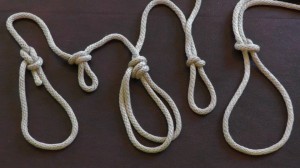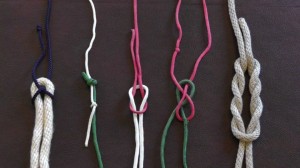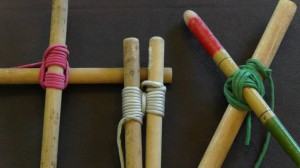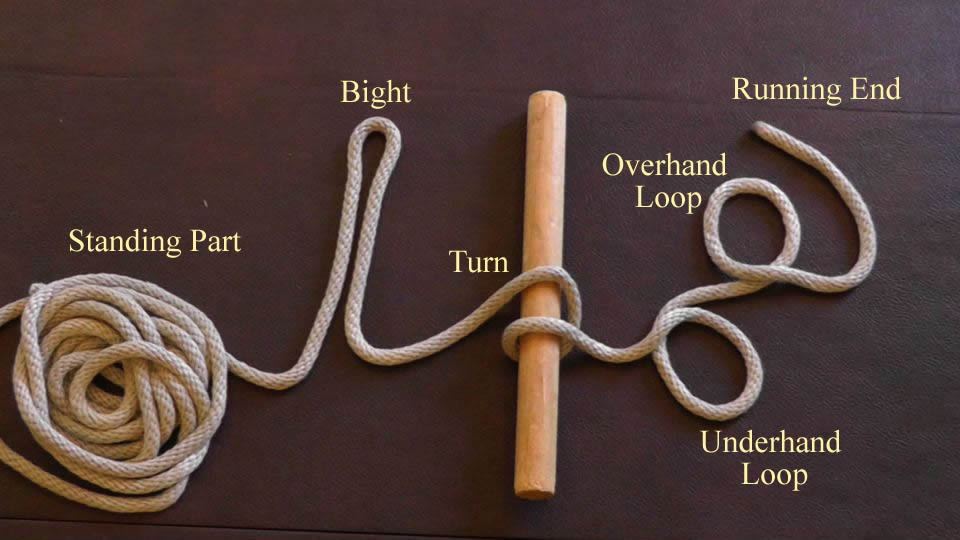Wilderness Knot Learning Objectives
After completing this section you should be able to:
- Identify the characteristics of a good knot
- Identify the major categories of knots
- Identify common rope and knot terms
- Tie three common knots: bowline, clove-hitch, and sheet bend
- Repair or prevent a rope from fraying
Identify the Characteristics of a Good Knot
At some point in the wilderness, you will probably need to secure something, repair something, or perhaps even build something. Having a basic understanding of knots is a valuable skill. Unless you know what you are doing, there may be a fine line between a quality knot and a completely tangled mess.
Quality knots have three things in common:
- easy to tie,
- serve a specific purpose
- easy to untie
Identify the major categories of knots
Knots can be grouped into a few major categories: loops, hitches, bends, and lashings.
Loops

Loops are knots used to create an attachment point or a hold in a rope. They are usually created by tying the rope to itself. Common uses in the wilderness include: attach a bear bag to a rope, creating a rescue throw rope, hanging a lantern or by-passing weak spot in a rope.

Video Demonstrations of Tying Loop Knots
Hitches

Hitches are knots used to tie a rope to an object. Common uses in the wilderness include: hanging a clothes line, putting up a rain fly, securing a boat, tying a bear bag to a tree, or starting and ending a lashing.

Video Demonstrations of Tying Hitches
Bends

Bends are knots used to tie ropes together. Some bends are better for uniting ropes of various diameters. Common uses in the wilderness include: lengthening a bear bag line, creating a bandage, or repairing a fishing line.

Video Demonstrations of Tying Bends
Lashings

Lashings are used to tie objects together. Common uses in the wilderness include: building a tripod, repairing a fishing pole, create a ladder, or build a bridge.

Video Demonstrations of Tying Lashings
Identify Common Rope and Knot Terms
A common language is helpful when describing how to tie a knot. Helpful terms include:
- Running End: the working end of the rope used to tie a knot.
- Standing Part: any part of the rope not considered the running end.
- Overhand Loop: a loop which crosses on top of the standing part.
- Underhand Loop: a loop which crosses under the standing part.
- Turn: a loop around an object.
- Bight: a bend in the rope which does not cross itself .
Tie three common knots.
Many people have there own personal favorite knots. They are usually the ones you remember how to tie and untie. If you are new to knots and do not yet have your own favorites, I would recommend the following three:
- Bowline: the most versatile loop knot. Does not slip, easy to untie even under stress, used for bear bags and rescue ropes.
- Sheet Bend: most versatile rope extension knot. Works well on ropes of varying diameters, easy to tie and untie.
- Clove Hitch: most versatile knot for fixing a rope to an object. Easy to tie and untie. Alternative methods for tying on the end of a rope over a”closed” object or tying in the middle of a rope over an “open ended” object. Used to quickly secure boats and start and end most lashings. Very easy to untie.
| Bowline | Sheet Bend |
| Clove Hitch (End of Rope) | Clove Hitch (Middle of Rope) |
Caring for your Rope
There are a variety of ways to prevent the end of a rope from fraying. The two most popular are fusing and whipping. To fuse a synthetic rope, melt the end with an open flame. To whip a rope, smaller string or twine is used to bind the end of the rope.
| Fuse a Rope | Whip a Rope |
Other Useful Knots:
After you have mastered the basic knots, you may want to check out these:

Video Demonstrations of Tying Other Knots
Wilderness Knot Review
You should be able to:
- Identify the characteristics of a good knot
- Identify the major categories of knots
- Identify common rope and knot terms
- Tie three common knots: bowline, clove-hitch, and sheet bend
- Repair or prevent a rope from fraying


Well done! I was sitting down to write a primer on knots for a friend of mine who wanted to learn 2 or 3 useful knots and then I came across this post. You know what? Try as I might, I can’t match the efficacy or brevity of what you’ve written here! Thus, your post is the first thing I will email to my friend. Thanks!